
The Local Group is the galaxy group that includes the Milky Way. It has a total diameter of roughly 3 megaparsecs (10 million light-years; 9×1019 kilometres), and a total mass of the order of 2×1012 solar masses (4×1042 kg). It consists of two collections of galaxies in a "dumbbell" shape; the Milky Way and its satellites form one lobe, and the Andromeda Galaxy and its satellites constitute the other. The two collections are separated by about 800 kiloparsecs (3×10^6 ly; 2×1019 km) and are moving toward one another with a velocity of 123 km/s. The group itself is a part of the larger Virgo Supercluster, which may be a part of the Laniakea Supercluster. The exact number of galaxies in the Local Group is unknown as some are occluded by the Milky Way; however, at least 80 members are known, most of which are dwarf galaxies.
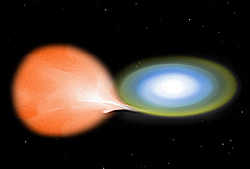
A nova is a transient astronomical event that causes the sudden appearance of a bright, apparently "new" star that slowly fades over weeks or months. Causes of the dramatic appearance of a nova vary, depending on the circumstances of the two progenitor stars. All observed novae involve white dwarfs in close binary systems. The main sub-classes of novae are classical novae, recurrent novae (RNe), and dwarf novae. They are all considered to be cataclysmic variable stars.
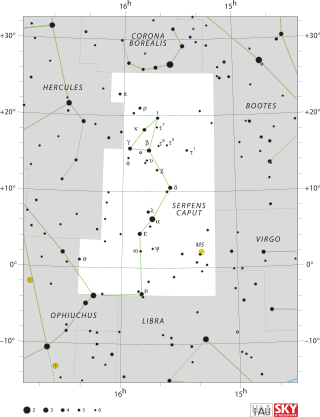
Serpens is a constellation in the northern celestial hemisphere. One of the 48 constellations listed by the 2nd-century astronomer Ptolemy, it remains one of the 88 modern constellations designated by the International Astronomical Union. It is unique among the modern constellations in being split into two non-contiguous parts, Serpens Caput to the west and Serpens Cauda to the east. Between these two halves lies the constellation of Ophiuchus, the "Serpent-Bearer". In figurative representations, the body of the serpent is represented as passing behind Ophiuchus between Mu Serpentis in Serpens Caput and Nu Serpentis in Serpens Cauda.

Triangulum is a small constellation in the northern sky. Its name is Latin for "triangle", derived from its three brightest stars, which form a long and narrow triangle. Known to the ancient Babylonians and Greeks, Triangulum was one of the 48 constellations listed by the 2nd century astronomer Ptolemy. The celestial cartographers Johann Bayer and John Flamsteed catalogued the constellation's stars, giving six of them Bayer designations.
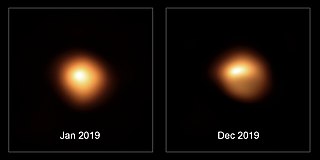
A variable star is a star whose brightness as seen from Earth changes with time. This variation may be caused by a change in emitted light or by something partly blocking the light, so variable stars are classified as either:

The Andromeda Galaxy is a barred spiral galaxy and is the nearest major galaxy to the Milky Way. It was originally named the Andromeda Nebula and is cataloged as Messier 31, M31, and NGC 224. Andromeda has a diameter of about 46.56 kiloparsecs and is approximately 765 kpc from Earth. The galaxy's name stems from the area of Earth's sky in which it appears, the constellation of Andromeda, which itself is named after the princess who was the wife of Perseus in Greek mythology.

Andromeda is one of the 48 constellations listed by the 2nd-century Greco-Roman astronomer Ptolemy, and one of the 88 modern constellations. Located in the northern celestial hemisphere, it is named for Andromeda, daughter of Cassiopeia, in the Greek myth, who was chained to a rock to be eaten by the sea monster Cetus. Andromeda is most prominent during autumn evenings in the Northern Hemisphere, along with several other constellations named for characters in the Perseus myth. Because of its northern declination, Andromeda is visible only north of 40° south latitude; for observers farther south, it lies below the horizon. It is one of the largest constellations, with an area of 722 square degrees. This is over 1,400 times the size of the full moon, 55% of the size of the largest constellation, Hydra, and over 10 times the size of the smallest constellation, Crux.
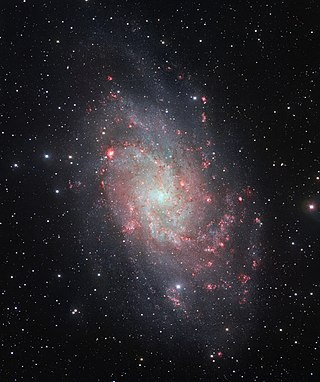
The Triangulum Galaxy is a spiral galaxy 2.73 million light-years (ly) from Earth in the constellation Triangulum. It is catalogued as Messier 33 or NGC (New General Catalogue) 598. With the D25 isophotal diameter of 18.74 kiloparsecs (61,100 light-years), the Triangulum Galaxy is the third-largest member of the Local Group of galaxies, behind the Andromeda Galaxy and the Milky Way.

V838 Monocerotis is a spectroscopic binary star system in the constellation Monoceros about 19,000 light years from the Sun. The previously unremarked star was observed in early 2002 experiencing a major outburst, and was one of the largest known stars for a short period following the outburst. Originally believed to be a typical nova eruption, it was then identified as the first of a new class of eruptive variables known as luminous red novae. The reason for the outburst is still uncertain, but is thought to have been a merger of two stars within a triple system.

This is a list of lists, grouped by type of astronomical object.
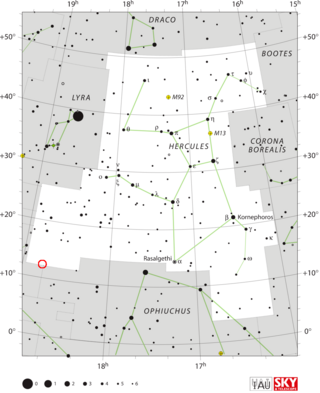
V838 Herculis, also known as Nova Herculis 1991, was a nova which occurred in the constellation Hercules in 1991. It was discovered by George Alcock of Yaxley, Cambridgeshire, England at 4:35 UT on the morning of 25 March 1991. He found it with 10×50 binoculars, and on that morning its apparent visual magnitude was 5. Palomar Sky Survey plates showed that before the outburst, the star was at photographic magnitude 20.6 and 18.25.

The Milky Way is the galaxy that includes the Solar System, with the name describing the galaxy's appearance from Earth: a hazy band of light seen in the night sky formed from stars that cannot be individually distinguished by the naked eye. The term Milky Way is a translation of the Latin via lactea, from the Greek γαλαξίας κύκλος, meaning "milky circle". From Earth, the Milky Way appears as a band because its disk-shaped structure is viewed from within. Galileo Galilei first resolved the band of light into individual stars with his telescope in 1610. Until the early 1920s, most astronomers thought that the Milky Way contained all the stars in the Universe. Following the 1920 Great Debate between the astronomers Harlow Shapley and Heber Doust Curtis, observations by Edwin Hubble showed that the Milky Way is just one of many galaxies.

The following outline is provided as an overview of and topical guide to astronomy:

A luminous red nova is a stellar explosion thought to be caused by the merging of two stars. They are characterised by a distinct red colour, and a light curve that fades slowly with resurgent brightness in the infrared. Luminous red novae are not related to standard novae, which are explosions that occur on the surface of white dwarf stars.
A luminous supersoft X-ray source is an astronomical source that emits only low energy X-rays. Soft X-rays have energies in the 0.09 to 2.5 keV range, whereas hard X-rays are in the 1–20 keV range. SSSs emit few or no photons with energies above 1 keV, and most have effective temperature below 100 eV. This means that the radiation they emit is highly ionizing and is readily absorbed by the interstellar medium. Most SSSs within our own galaxy are hidden by interstellar absorption in the galactic disk. They are readily evident in external galaxies, with ~10 found in the Magellanic Clouds and at least 15 seen in M31.

V339 Delphini or Nova Delphini 2013 (PNV J20233073+2046041) is a bright nova star in the constellation Delphinus. It was discovered on 14 August 2013 by amateur astronomer Koichi Itagaki in Japan and confirmed by the Liverpool Telescope on La Palma. The nova appeared with a magnitude 6.8 when it was discovered and peaked at magnitude 4.3 on 16 August 2013. A nova is produced by the fusion of accumulated material on the white dwarf nova progenitor acquired from its companion star. The nova system is thus a binary star, and a classical nova. The white dwarf is a carbon-oxygen white dwarf, with an estimated mass of 1.04±0.02 M☉. There is not yet a consensus about what the binay's orbital period is; estimates range from 3.15 hours to 6.43 hours.

RW Ursae Minoris is a cataclysmic variable star system that flared up as a nova in the constellation Ursa Minor in 1956.

V392 Persei, also known as Nova Persei 2018, is a bright nova in the constellation Perseus discovered on April 29, 2018. It was previously known as a dwarf nova.
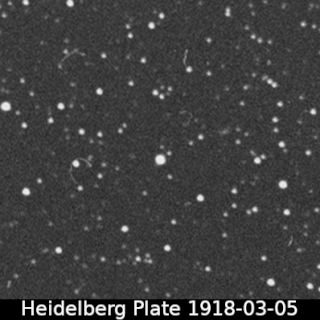
GI Monocerotis, also known as Nova Monocerotis 1918, was a nova that erupted in the constellation Monoceros during 1918. It was discovered by Max Wolf on a photographic plate taken at the Heidelberg Observatory on 4 February 1918. At the time of its discovery, it had a photographic magnitude of 8.5, and had already passed its peak brightness. A search of plates taken at the Harvard College Observatory showed that it had a photographic magnitude of 5.4 on 1 January 1918, so it would have been visible to the naked eye around that time. By March 1918 it had dropped to ninth or tenth magnitude. By November 1920 it was a little fainter than 15th magnitude.






















